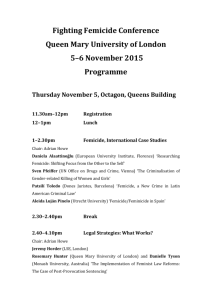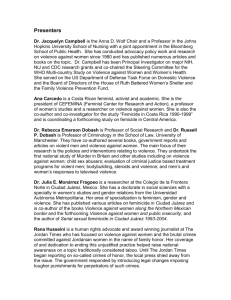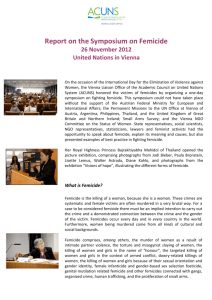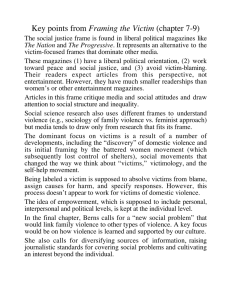A Femicide: A Global Problem
advertisement
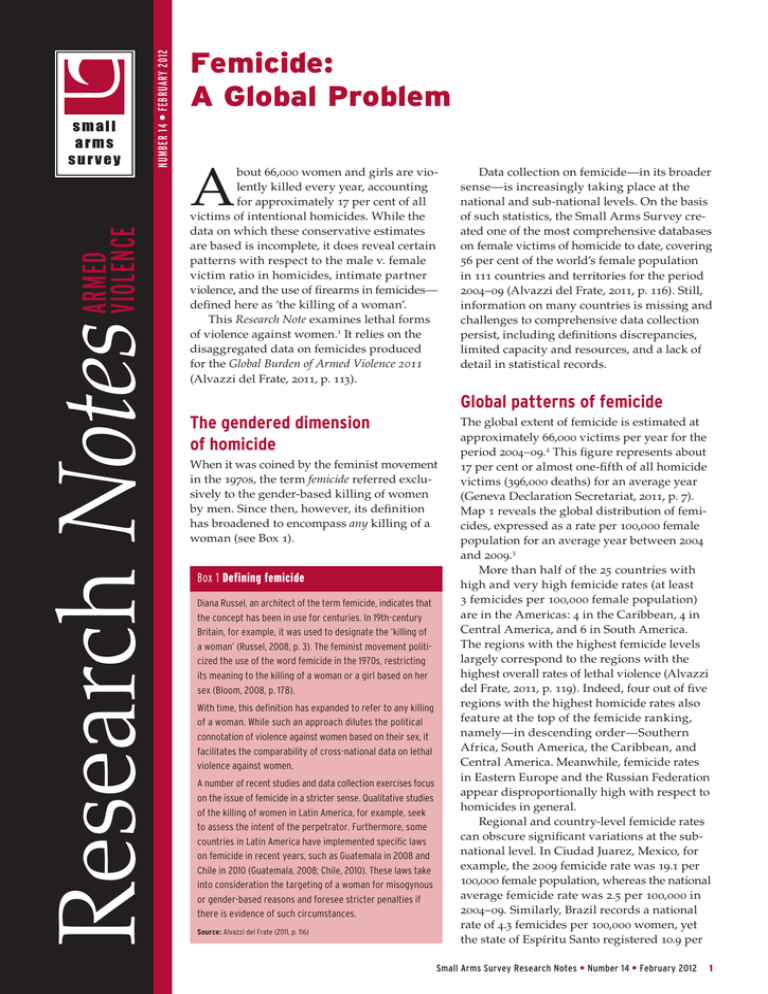
NUMBER 14 • FEBRUARY 2012 Research Notes ARMED VIOLENCE Femicide: A Global Problem A bout 66,000 women and girls are violently killed every year, accounting for approximately 17 per cent of all victims of intentional homicides. While the data on which these conservative estimates are based is incomplete, it does reveal certain patterns with respect to the male v. female victim ratio in homicides, intimate partner violence, and the use of firearms in femicides— defined here as ‘the killing of a woman’. This Research Note examines lethal forms of violence against women.1 It relies on the disaggregated data on femicides produced for the Global Burden of Armed Violence 2011 (Alvazzi del Frate, 2011, p. 113). Data collection on femicide—in its broader sense—is increasingly taking place at the national and sub-national levels. On the basis of such statistics, the Small Arms Survey created one of the most comprehensive databases on female victims of homicide to date, covering 56 per cent of the world’s female population in 111 countries and territories for the period 2004–09 (Alvazzi del Frate, 2011, p. 116). Still, information on many countries is missing and challenges to comprehensive data collection persist, including definitions discrepancies, limited capacity and resources, and a lack of detail in statistical records. Global patterns of femicide The gendered dimension of homicide When it was coined by the feminist movement in the 1970s, the term femicide referred exclusively to the gender-based killing of women by men. Since then, however, its definition has broadened to encompass any killing of a woman (see Box 1). Box 1 Defining femicide Diana Russel, an architect of the term femicide, indicates that the concept has been in use for centuries. In 19th-century Britain, for example, it was used to designate the ‘killing of a woman’ (Russel, 2008, p. 3). The feminist movement politicized the use of the word femicide in the 1970s, restricting its meaning to the killing of a woman or a girl based on her sex (Bloom, 2008, p. 178). With time, this definition has expanded to refer to any killing of a woman. While such an approach dilutes the political connotation of violence against women based on their sex, it facilitates the comparability of cross-national data on lethal violence against women. A number of recent studies and data collection exercises focus on the issue of femicide in a stricter sense. Qualitative studies of the killing of women in Latin America, for example, seek to assess the intent of the perpetrator. Furthermore, some countries in Latin America have implemented specific laws on femicide in recent years, such as Guatemala in 2008 and Chile in 2010 (Guatemala, 2008; Chile, 2010). These laws take into consideration the targeting of a woman for misogynous or gender-based reasons and foresee stricter penalties if there is evidence of such circumstances. Source: Alvazzi del Frate (2011, p. 116) The global extent of femicide is estimated at approximately 66,000 victims per year for the period 2004–09.2 This figure represents about 17 per cent or almost one-fifth of all homicide victims (396,000 deaths) for an average year (Geneva Declaration Secretariat, 2011, p. 7). Map 1 reveals the global distribution of femicides, expressed as a rate per 100,000 female population for an average year between 2004 and 2009.3 More than half of the 25 countries with high and very high femicide rates (at least 3 femicides per 100,000 female population) are in the Americas: 4 in the Caribbean, 4 in Central America, and 6 in South America. The regions with the highest femicide levels largely correspond to the regions with the highest overall rates of lethal violence (Alvazzi del Frate, 2011, p. 119). Indeed, four out of five regions with the highest homicide rates also feature at the top of the femicide ranking, namely—in descending order—Southern Africa, South America, the Caribbean, and Central America. Meanwhile, femicide rates in Eastern Europe and the Russian Federation appear disproportionally high with respect to homicides in general. Regional and country-level femicide rates can obscure significant variations at the subnational level. In Ciudad Juarez, Mexico, for example, the 2009 femicide rate was 19.1 per 100,000 female population, whereas the national average femicide rate was 2.5 per 100,000 in 2004–09. Similarly, Brazil records a national rate of 4.3 femicides per 100,000 women, yet the state of Espíritu Santo registered 10.9 per Small Arms Survey Research Notes • Number 14 • February 2012 1 Map 1 Rates of female homicide victims per 100,000 female population, 2004–09 LEGEND: Per 100,00 women >6 3–6 2–3 1–2 <1 No data Source: Alvazzi del Frate (2011, p. 118) 100,000 in 2008. Settings with particularly high femicide rates also exhibit high levels of tolerance of violence against women; moreover, their criminal justice systems tend to be inefficient and lack the resources—or political will—needed to fully investigate and prosecute femicide cases (Alvazzi del Frate, 2011, p. 122). The following sections discuss femicide in the contexts of male v. female victim ratio in homicides; intimate partner violence (IPV); and the use of firearms in lethal violence against women. women are killed for every 100 men. In contrast, in countries affected by high and very high levels of homicide, the disparity between the sexes is significantly greater at 16.3 and 12.5 women per 100 men, respectively. In other words, as the homicide rate increases, the number of women killed in comparison to men appears to decrease. Yet whereas men are up to ten times more likely than women to become victims of a homicide in countries such as Brazil, Colombia, Puerto Rico, and Venezuela, women are by no means safer in these settings than elsewhere; indeed, these countries witnessed the highest femicide rates of the period under review (Alvazzi del Frate, 2011, p. 123). The highest femicide rates can be observed in countries and territories affected by high or very high overall Figure 1 Femicide rate and number of femicide victims for every 100 male homicide victims in 83 countries, 2004–09 Homicide victims: women v. men Number of femicides for every 100 male homicide victims As noted above, countries with the highest levels of homicide generally show the highest rates of lethal violence against women. However, the ratios of male to female homicide victims across countries reveal a different trend. In Figure 1, the line shows the rate of femicide per 100,000 women across five categories of overall homicide rates (from very low to very high) in 83 countries; the bars indicate the number of femicide victims for every 100 male homicide victims in the same five categories. In the 13 countries with very low overall homicide rates, about 66 90 Femicide rate per 100,000 female population 45 Number of femicides for every 100 male homicides 80 40 Femicide rate per 100,000 female population 70 35 60 30 50 25 40 20 30 15 20 10 10 5 Very low (<1) Low (1–3) Medium (3–10) High (10–30) Very high (>30) 13 countries 30 countries 20 countries 13 countries 7 countries Homicide rate per 100,000 overall population Source: GBAV 2011 femicide database 2 Small Arms Survey Research Notes • Number 14 • February 2012 Figure 2 Average femicide rates per 100,000 female population in 25 countries and territories with high and very high rates, 2004–09 El Salvador Jamaica Guatemala South Africa Russian Federation Guyana Honduras Azerbaijan Lesser Antilles Region Colombia Bolivia Very high Bahamas Lithuania High Belarus Venezuela Latvia Belize Kazakhstan Moldova Brazil Kyrgyzstan Ukraine Ecuador Dominican Republic Estonia 0 1 2 3 4 5 6 7 8 9 10 11 12 Rate per 100,000 female population Source: Alvazzi del Frate (2011, p. 120) homicide rates (see Figure 2). With a rate of 12.0 per 100,000 people, El Salvador is the country with the highest femicide rate, followed by Jamaica (10.9), Guatemala (9.7), and South Africa (9.6). In countries marked by high levels of lethal violence, women are more frequently attacked in the public sphere, including by gangs and organized criminal groups; in this context, femicides often take place in a general climate of indifference and impunity. Intimate partner violence The majority of perpetrators of femicides are male, frequently family members or friends of the victim, and often a current or former intimate partner. The close relationship between perpetrators and victims can sometimes facilitate identification of the author of the crime. A sample study of 54 countries and territories providing information on relationships between perpetrators and victims of femicide reveals that the proportion of IPV-related lethal violence is rather low in countries with high femicide rates. For example, in El Salvador and Colombia, which feature among the countries with the highest femicide rates, only three per cent of all femicides are committed by a current or former intimate partner, whereas in Cyprus, France, and Portugal (all countries with low or very low femicide rates) killings of women by former and current partners account for more than 80 per cent of all cases (Alvazzi del Frate, 2011, pp. 129–30). Strikingly, the majority of IPVrelated femicide victims experienced prior violence and physical abuse from the same perpetrator (Campbell et al., 2003, p. 1091). IPV-related victimization often leads to self-directed violence. In the United States, for example, 35 to 40 per cent of victims who survived domestic violence attempted to commit suicide at some point during or after the termination of the abusive relationship. Research conducted in the European Union reveals that of all cases of deaths occurring in the wake of spousal violence, 42 per cent were due to suicide (Psytel, 2010, pp. 9–10). Firearms Firearms play an important role in lethal violence. The Global Burden of Armed Violence 2008 estimates that on average 60 per cent of all homicides are committed with firearms (Geneva Declaration Secretariat, 2008, p. 5). The display of firearms—as a means to intimidate, threaten, or coerce someone—is a predictor of their actual use. Small Arms Survey Research Notes • Number 14 • February 2012 3 Many women report having been threatened with a firearm before they fall victim to a femicide. Firearms in the home similarly represent an increased risk to women as they are more likely to be used to threaten and inflict harm on family members than to protect the home from intruders (Alvazzi del Frate, 2011, p. 131). Analysis of a sample of 24 countries with detailed data on the type of weapons used in committing femicides reveals a direct correlation between femicide rates and the use of firearms. Specifically, countries affected by high levels of femicide exhibit a higher proportion of femicides committed with firearms. On average, firearms were used in one-third of all femicides worldwide; in Brazil, Colombia, El Salvador, Guatemala, and Honduras, however, firearms were used in more than 60 per cent of femicides (Alvazzi del Frate, 2011, p. 131). The highest percentage of firearm-related femicides was observed in 2009 in Ciudad Juarez, Mexico, where firearms were used in more than 80 per cent of all femicides—almost as high a percentage as for firearm homicides with male victims (p. 132). Conclusions While men comprise the majority of homicide victims in countries with high levels of violence, a woman’s risk of being killed is also highest in these settings. Wherever gun violence levels are spiralling out of control, the risk of victimization increases for the entire male and female population. Intimate partner violence is widespread and rarely limited to an isolated episode. As part of an abusive relationship, it can easily become lethal. Prolonged exposure to intolerable levels of violence at home can also lead a victim to commit ‘forced suicide’. The availability of detailed data on characteristics of victims and perpetrators, circumstances, relationships, and causes of lethal events is increasing, encouraging research on femicide and other forms of armed violence. Nevertheless, serious information gaps and incomplete geographical coverage continue to hamper research. Other forms of lethal violence suffered by women—such as dowry deaths— need to be incorporated in future re- search. Accurate information is a key to understanding the characteristics of femicide and to developing sound, evidence-based policy responses to enhance security for women around the globe. Notes 1 2 3 This Research Note summarizes the main findings of Alvazzi del Frate (2011). This figure was ‘calculated by applying regional rates of femicide to the populations of countries with missing information and using the global rate for regions with no data’ (Alvazzi del Frate, 2011, p. 117). Important data gaps can clearly be identified, especially in Africa and Asia, where homicide data disaggregated by sex is lacking. References Alvazzi del Frate, Anna. 2011. ‘When the Victim Is a Woman.’ In Geneva Declaration Secretariat, pp. 113–144. <http:// www.genevadeclaration.org/fileadmin/ docs/GBAV2/GBAV2011_CH4.pdf> Bloom, Shelah. 2008. Violence against Women and Girls: A Compendium of Monitoring and Evaluation Indicators. Chapel Hill, NC: MEASURE Evaluation. <http://www. cpc.unc.edu/measure/publications/ ms-08-30/at_download/document> Campbell, Jacquelyn, et al. 2003. ‘Risk Factors for Femicide in Abusive Relationships: Results from a Multisite Case Control Study.’ American Journal of Public Health, Vol. 93, No. 7. July, pp. 1089–97. <http:// ajph.aphapublications.org/cgi/content/ abstract/93/7/1089> Chile. 2010. Ley 20.480. Santiago: Biblioteca del Congreso Nacional de Chile. 18 December. <http://www.eclac.cl/oig/doc/LEY20480_18-DIC-2010.pdf> Geneva Declaration Secretariat. 2008. Global Burden of Armed Violence. Geneva: Geneva Declaration Secretariat. —. 2011. Global Burden of Armed Violence 2011: Lethal Encounters. Cambridge: Cambridge University Press. Guatemala. 2008. Ley contra el femicidio y otras formas de violencia contra la mujer. Decreto Número 22-2008. Guatemala City: Congreso de la República de Guatemala. 2 May. <http://www.eclac.cl/oig/doc/ Gua2008LeycontraFemicidio.pdf> Psytel. 2010. Estimation de la mortalité liée aux violences conjugales en Europe: ‘IPV EU Mortality.’ DAPHNE Projet No. JLS/2007/ DAP-1/140. Rapport scientifique. <http:// www.psytel.eu/violences.php> Russel, Diana. 2008. ‘Femicide: Politicizing the Killing of Females.’ Paper presented at the Interagency Gender Working Group Meeting on Strengthening Understanding of Femicide, Washington, DC. May. <http:// www.igwg.org/Events/femicide.aspx> For more information on the Geneva Declaration on Armed Violence and Development, please visit: www.genevadeclaration.org. 4 Small Arms Survey Research Notes • Number 14 • February 2012 About the Small Arms Survey The Small Arms Survey serves as the principal international source of public information on all aspects of small arms and armed violence, and as a resource centre for governments, policy-makers, researchers, and activists. The Survey distributes its findings through Occasional Papers, Issue Briefs, Working Papers, Special Reports, Books, and its annual flagship publication, the Small Arms Survey. The project has an international staff with expertise in security studies, political science, international public policy, law, economics, development studies, conflict resolution, sociology, and criminology, and works closely with a worldwide network of researchers and partners. The Small Arms Survey is a project of the Graduate Institute of International and Development Studies, Geneva. For more information see www.smallarmssurvey.org. Publication date: February 2012 Credits Author: Matthias Nowak Copy-editing: Tania Inowlocki Design and layout: Richard Jones (rick@ studioexile.com) Contact details Small Arms Survey Graduate Institute of International and Development Studies 47 Avenue Blanc 1202 Geneva, Switzerland t +41 22 908 5777 f +41 22 732 2738
